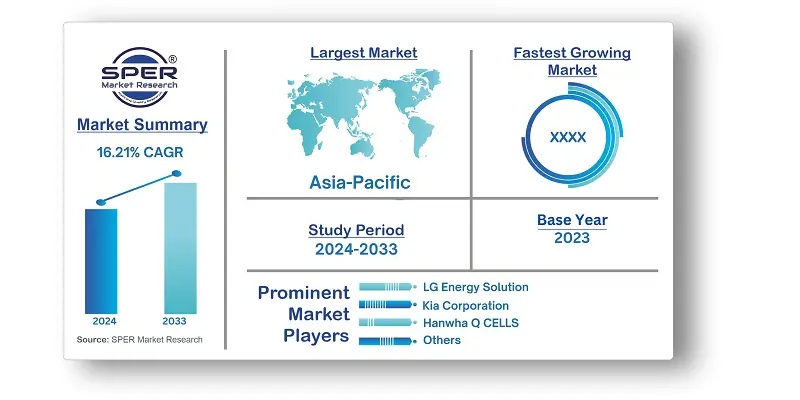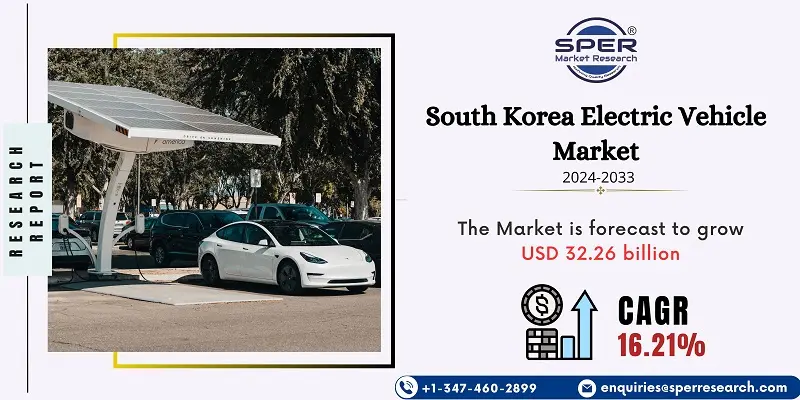
South Korea Electric Vehicle Market Growth, Size, Trends, Share, Revenue and Future Outlook
South Korea Electric Vehicle Market Size- By Vehicle Type, By Propulsion, By Drive Type- Regional Outlook, Competitive Strategies and Segment Forecast to 2033
| Published: Jul-2024 | Report ID: AMIN24163 | Pages: 1 - 107 | Formats*: |
| Category : Automotive & Transportation | |||
- June 2024; Aggressive initiatives have been initiated by the South Korean government to encourage technological developments in e-mobility. By developing new platforms and utilizing locally produced battery components, these initiatives seek to lower the cost of electric vehicles. Targets include increasing fuel efficiency by at least 15% and the range of electric and hydrogen-powered vehicles. Additionally, the government intends to encourage the use of eco-friendly automobiles in the public sector and commercialize solid-state batteries.
- May 2024; Hyundai and Microsoft Korea have teamed up to create digital twin technology, which will improve battery management and life prediction. This system analyzes different data points using models based on the cloud, which could result in better battery life and performance for electric vehicles.


| Report Metric | Details |
| Market size available for years | 2020-2033 |
| Base year considered | 2023 |
| Forecast period | 2024-2033 |
| Segments covered | By Vehicle Type, By Propulsion, By Drive Type |
| Regions covered | Northern Region, Southern Region, Western Region, Eastern Region, Central Region |
| Companies Covered | Hanwha Q CELLS, Hyundai Mobis, Hyundai Motor Company, Kia Corporation, LG Energy Solution, POSCO, Renault Samsung Motors, Samsung SDI, SK Innovation, and SsangYong Motor Company. |
- Urban Commuters
- Environmental Enthusiasts
- Tech Savvy Consumers
- Corporate Fleets
- Ride Sharing Companies
- Younger Generation
| By Vehicle Type: |
|
| By Propulsion: |
|
| By Drive Type: |
|
- South Korea Electric Vehicle Market Size (FY’2024-FY’2033)
- Overview of South Korea Electric Vehicle Market
- Segmentation of South Korea Electric Vehicle Market by Vehicle Type (Commercial Vehicle, Passenger Vehicle, Two Wheelers)
- Segmentation of South Korea Electric Vehicle Market by Propulsion (BEV, PHEV, FCEV)
- Segmentation of South Korea Electric Vehicle Market by Drive Type (Front Wheel Drive, Rear Wheel Drive, All Wheel Drive)
- Statistical Snap of South Korea Electric Vehicle Market
- Expansion Analysis of South Korea Electric Vehicle Market
- Problems and Obstacles in South Korea Electric Vehicle Market
- Competitive Landscape in the South Korea Electric Vehicle Market
- Impact of COVID-19 and Demonetization on South Korea Electric Vehicle Market
- Details on Current Investment in South Korea Electric Vehicle Market
- Competitive Analysis of South Korea Electric Vehicle Market
- Prominent Players in the South Korea Electric Vehicle Market
- SWOT Analysis of South Korea Electric Vehicle Market
- South Korea Electric Vehicle Market Future Outlook and Projections (FY’2024-FY’2033)
- Recommendations from Analyst
1.1. Scope of the report1.2. Market segment analysis
2.1. Research data source
2.1.1. Secondary Data2.1.2. Primary Data2.1.3. SPER’s internal database2.1.4. Premium insight from KOL’s
2.2. Market size estimation
2.2.1. Top-down and Bottom-up approach
2.3. Data triangulation
4.1. Driver, Restraint, Opportunity and Challenges analysis
4.1.1. Drivers4.1.2. Restraints4.1.3. Opportunities4.1.4. Challenges
4.2. COVID-19 Impacts of the South Korea Electric Vehicle Market.
5.1. SWOT Analysis
5.1.1. Strengths5.1.2. Weaknesses5.1.3. Opportunities5.1.4. Threats
5.2. PESTEL Analysis
5.2.1. Political Landscape5.2.2. Economic Landscape5.2.3. Social Landscape5.2.4. Technological Landscape5.2.5. Environmental Landscape5.2.6. Legal Landscape
5.3. PORTER’s Five Forces
5.3.1. Bargaining power of suppliers5.3.2. Bargaining power of buyers5.3.3. Threat of Substitute5.3.4. Threat of new entrant5.3.5. Competitive rivalry
5.4. Heat Map Analysis
6.1. South Korea Electric Vehicle Market Manufacturing Base Distribution, Sales Area, Product Type6.2. Mergers & Acquisitions, Partnerships, Product Launch, and Collaboration in South Korea Electric Vehicle Market
7.1. South Korea Electric Vehicle Market Size, Share and Forecast, By Vehicle Type, 2020-20267.2. South Korea Electric Vehicle Market Size, Share and Forecast, By Vehicle Type, 2027-20337.3. Commercial Vehicle7.4. Passenger Vehicle7.5. Two Wheelers
8.1. South Korea Electric Vehicle Market Size, Share and Forecast, By Propulsion, 2020-20268.2. South Korea Electric Vehicle Market Size, Share and Forecast, By Propulsion, 2027-20338.3. BEV8.4. PHEV8.5. FCEV
9.1. South Korea Electric Vehicle Market Size, Share and Forecast, By Drive Type, 2020-20269.2. South Korea Electric Vehicle Market Size, Share and Forecast, By Drive Type, 2027-20339.3. Front Wheel Drive9.4. Rear Wheel Drive9.5. All Wheel Drive
10.1. South Korea Electric Vehicle Market Size and Market Share
11.1. South Korea Electric Vehicle Market Size and Market Share By Region (2020-2026)11.2. South Korea Electric Vehicle Market Size and Market Share By Region (2027-2033)11.3. Northern Region11.4. Southern Region11.5. Western Region11.6. Eastern Region11.7. Southern Region
12.1. HANWHA Q CELLS
12.1.1. Company details12.1.2. Financial outlook12.1.3. Product summary12.1.4. Recent developments
12.2. HYUNDAI MOTOR COMPANY
12.2.1. Company details12.2.2. Financial outlook12.2.3. Product summary12.2.4. Recent developments
12.3. KIA CORPORATION
12.3.1. Company details12.3.2. Financial outlook12.3.3. Product summary12.3.4. Recent developments
12.4. LG ENERGY SOLUTION
12.4.1. Company details12.4.2. Financial outlook12.4.3. Product summary12.4.4. Recent developments
12.5. POSCO
12.5.1. Company details12.5.2. Financial outlook12.5.3. Product summary12.5.4. Recent developments
12.6. RENAULT SAMSUNG MOTORS
12.6.1. Company details12.6.2. Financial outlook12.6.3. Product summary12.6.4. Recent developments
12.7. SAMSUNG SDI
12.7.1. Company details12.7.2. Financial outlook12.7.3. Product summary12.7.4. Recent developments
12.8. SK INNOVATION
12.8.1. Company details12.8.2. Financial outlook12.8.3. Product summary12.8.4. Recent developments
12.9. SSANGYONG MOTOR COMPANY
12.9.1. Company details12.9.2. Financial outlook12.9.3. Product summary12.9.4. Recent developments
12.10. Others
SPER Market Research’s methodology uses great emphasis on primary research to ensure that the market intelligence insights are up to date, reliable and accurate. Primary interviews are done with players involved in each phase of a supply chain to analyze the market forecasting. The secondary research method is used to help you fully understand how the future markets and the spending patterns look likes.
The report is based on in-depth qualitative and quantitative analysis of the Product Market. The quantitative analysis involves the application of various projection and sampling techniques. The qualitative analysis involves primary interviews, surveys, and vendor briefings. The data gathered as a result of these processes are validated through experts opinion. Our research methodology entails an ideal mixture of primary and secondary initiatives.



Frequently Asked Questions About This Report
PLACE AN ORDER
Year End Discount
Sample Report
Pre-Purchase Inquiry
NEED CUSTOMIZATION?
Request CustomizationCALL OR EMAIL US
100% Secure Payment






Related Reports
Our Global Clients
Our data-driven insights have influenced the strategy of 200+ reputed companies across the globe.






















